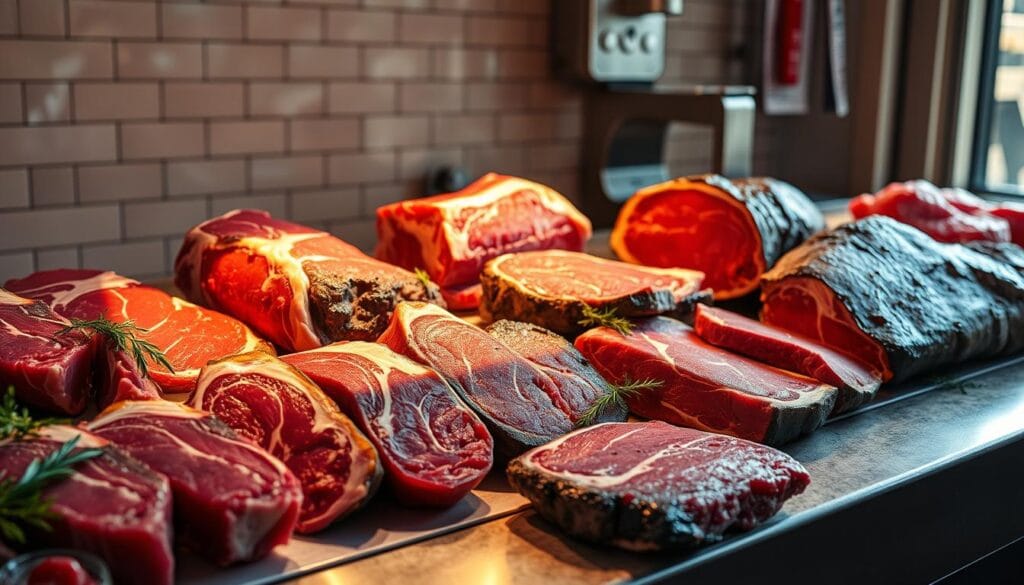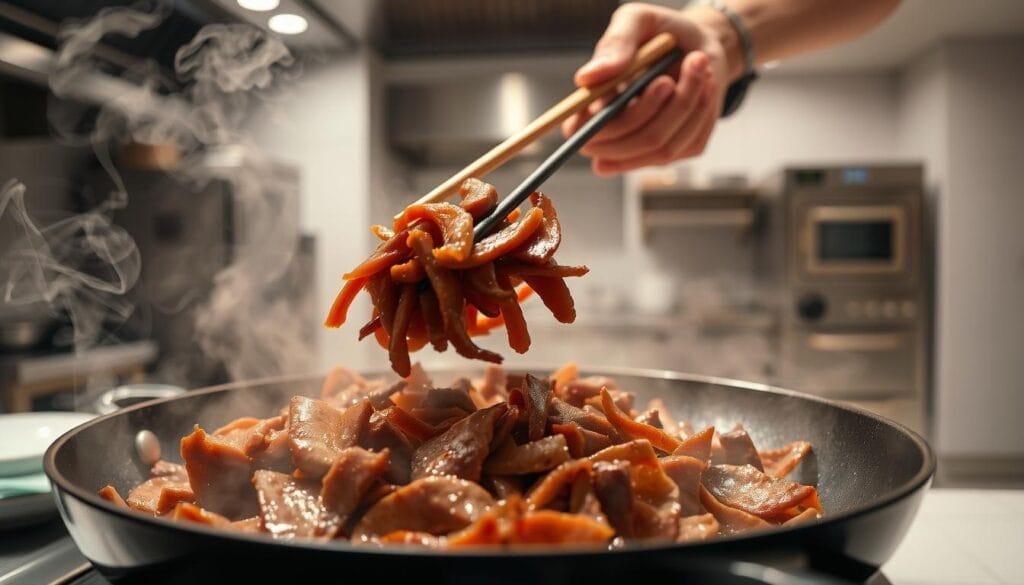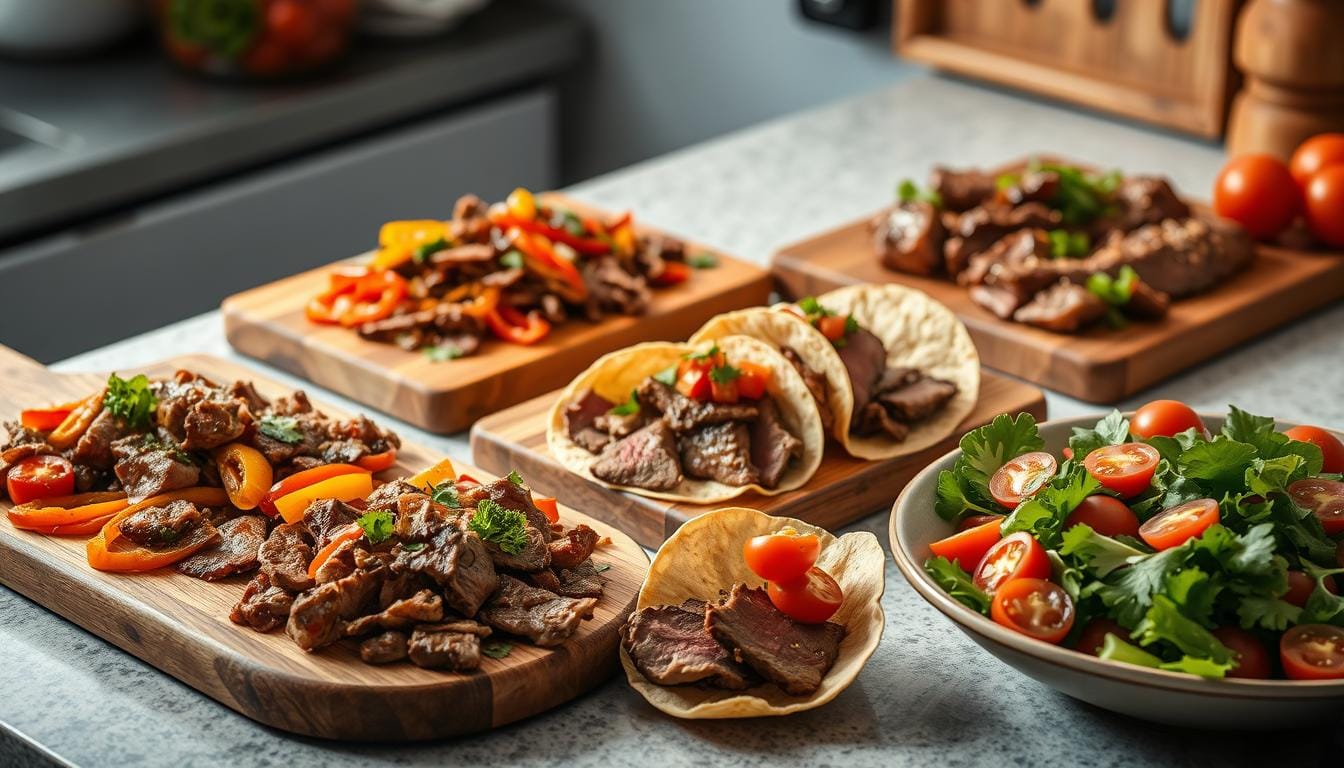Enjoy the Taste of Tender Thin Sliced Beef
There’s something undeniably satisfying about a perfectly cooked dish that’s both flavorful and quick to prepare. If you’ve ever wondered how to elevate your weeknight meals, tender beef cuts might just be the answer. Their ability to absorb marinades and cook in minutes makes them a go-to choice for busy cooks.
Take inspiration from dishes like Mongolian beef, where the meat is seared to create a rich, caramelized glaze. This technique not only locks in flavor but also ensures a melt-in-your-mouth texture. Whether you’re stir-frying or pan-searing, the key lies in the preparation and cooking process.
In this guide, you’ll discover expert tips to achieve restaurant-quality results at home. From selecting the right cuts to mastering high-heat cooking, we’ll walk you through every step. Get ready to transform your kitchen into a culinary haven with these simple yet impactful techniques.
Key Takeaways
- Tender beef cuts are perfect for quick, flavorful meals.
- Proper slicing enhances tenderness and marinade absorption.
- High-heat cooking ensures a caramelized, flavorful finish.
- Dishes like Mongolian beef showcase the versatility of this technique.
- Expert tips will help you achieve restaurant-quality results at home.
Understanding Thin Sliced Beef: A Guide to Tender Results
Achieving tender, flavorful results with meat starts with understanding the basics of preparation. When meat is thinly sliced, it cooks faster and absorbs marinades more effectively. This technique is especially useful for dishes like stir-fries or cheesesteaks, where even cooking and tenderness are key.
The quality of the cut plays a significant role in the final texture. For example, ribeye and flank steak are popular choices because they balance flavor and tenderness. Proper slicing against the grain ensures the meat remains soft and easy to chew.
Marination is another critical step. A good marinade not only enhances flavor but also helps break down the meat’s fibers, making it more tender. High-heat cooking methods, like stir-frying, seal in juices and create a delicious caramelized exterior.
Popular recipes, such as Mongolian beef or Philly cheesesteaks, showcase the versatility of this technique. By choosing the right ingredient and mastering the slicing process, you can elevate your home cooking to restaurant-quality standards.
Selecting and Preparing Your Beef
The secret to a perfect dish lies in the preparation and selection of the right ingredients. When it comes to beef, choosing the right cut and mastering the slicing process are essential steps. Whether you’re making stir-fries or sandwiches, the right technique ensures tender, flavorful results.

Choosing the Right Cut and Slicer
Not all cuts are created equal. For thin slicing, options like shaved steak or sandwich steak are ideal. These cuts balance flavor and tenderness, making them perfect for quick cooking. If you’re unsure, your local butcher can provide expert advice and even slice the meat for you.
Using a meat slicer at home can also yield excellent results. For best outcomes, freeze the meat for about 30 minutes before slicing. This makes it firm enough to handle without being fully frozen.
Proper Thawing and Slicing Techniques
Thawing your beef correctly is crucial. Aim for a partially thawed state—firm but not frozen. This makes slicing easier and ensures even cooking. Always slice against the grain to maintain tenderness.
When preparing to cook, keep your pan warm and ready. This helps achieve a caramelized exterior while locking in juices. Follow these steps, and you’ll be on your way to creating restaurant-quality dishes at home.
Mastering Marinades and Seasoning Techniques
Unlock the full potential of your meals with the art of marinating and seasoning. A great marinade not only adds flavor but also tenderizes, ensuring every bite is juicy and delicious. Whether you’re preparing a quick stir-fry or a hearty main dish, the right combination of ingredients can make all the difference.
Classic Soy, Ginger, and Garlic Marinade
This marinade is a staple in many Asian-inspired recipes. It combines savory soy sauce with the warmth of ginger and the sharpness of garlic. Here’s how to make it:
- Mix ½ cup of soy sauce, 1 tablespoon of minced ginger, and 2 cloves of minced garlic.
- Add a dash of oil to help the flavors blend and coat the meat evenly.
- Let the meat marinate for at least 30 minutes, or up to 2 hours for deeper flavor.
For a glazy finish, sauté the aromatics in a hot pan for 30 seconds before adding the sauce. This technique enhances the dish’s richness and aroma.
Enhancing Flavor with Honey and Brown Sugar
Adding a touch of sweetness can balance the savory notes of your marinade. Honey and brown sugar are perfect for this. Here’s a simple recipe:
- Combine 2 tablespoons of soy sauce, 1 tablespoon of honey, and 1 tablespoon of brown sugar.
- Add a teaspoon of cornstarch to thicken the sauce and create a glossy coating.
- Marinate the meat for 15-20 minutes before cooking.
This marinade works wonders for stir-fries and grilled dishes. Adjust the sweetness to suit your taste and the specific recipe you’re preparing.
Remember, the key to a great marinade is balance. Experiment with different ingredients to find your perfect blend. With these techniques, you’ll elevate your cooking and impress everyone at the table.
Quick and Effective Searing and Stir-Frying Methods
Mastering the art of searing and stir-frying can transform your meals into restaurant-quality dishes. These techniques preserve tenderness while creating a flavorful, caramelized exterior. With the right approach, you can achieve perfect results every time.

Sautéing for Even Browning and Glazing
Start by preheating a large pan over medium-high heat. Add a controlled amount of oil to ensure even browning. For best results, dust your meat with cornstarch before cooking. This helps create a crisp, golden exterior.
Sauté in small batches to avoid overcrowding the pan. Overcrowding lowers the heat, leading to steaming instead of searing. Turn each piece to ensure an even glaze while preserving moisture.
Maintaining Tender Texture During High Heat Cooking
High heat is essential for quick cooking, but it’s crucial to control it to retain tenderness. Keep the pan hot but not smoking. Add aromatics like onion and garlic at the right moment to enhance flavor without compromising texture.
Here’s a quick guide to ensure success:
- Preheat the pan for at least a minute before adding oil.
- Cook in small batches to maintain high heat.
- Turn each piece frequently for even browning.
- Add aromatics halfway through cooking for maximum flavor.
| Nutritional Information (Per Serving) | Value |
|---|---|
| Calories | 786 kcal |
| Protein | 44 g |
| Fat | 30 g |
| Carbohydrates | 88 g |
| Sodium | 2077 mg |
With these techniques, you’ll create dishes that are both tender and bursting with flavor. Experiment with different ingredients and methods to find your perfect balance.
Exploring Global Inspirations in Thin Sliced Beef Recipes
Exploring global cuisines can open up a world of flavors, especially when using versatile ingredients like tender cuts of meat. From Asian stir-fries to American cheesesteaks, these recipes showcase how one ingredient can adapt to multiple culinary traditions.
Asian-Inspired Stir-Fries and Bulgogi Variations
Asian cuisine offers a treasure trove of recipes that highlight the versatility of meat. Bulgogi, a Korean classic, features marinated cuts grilled to perfection. The marinade, often made with soy sauce, garlic, and sesame oil, infuses the meat with rich, savory flavors.
Stir-fries are another popular option. Pair your meat with vegetables like broccoli and toss it in a teriyaki or spicy chili sauce for a quick, flavorful meal. These dishes are not only delicious but also easy to prepare, making them perfect for busy weeknights.
Cheesesteak and Fusion Dish Ideas
For a taste of American comfort food, try a modern take on the classic cheesesteak. Use tender cuts and sauté them with onions and peppers for a hearty sandwich. Add a twist by incorporating international flavors, like a spicy sriracha mayo or a tangy chimichurri sauce.
Fusion dishes allow you to experiment with global flavors. Combine the richness of Asian marinades with the simplicity of a cheesesteak for a unique culinary experience. The possibilities are endless when you let your creativity guide you.
Here are some tips to get started:
- Experiment with different sauces, like teriyaki or gochujang, to add depth to your dishes.
- Pair your meat with staples like rice or noodles for a complete meal.
- Don’t shy away from adding vegetables like broccoli for extra nutrition and texture.
By exploring these global inspirations, you can transform your kitchen into a hub of culinary creativity. Try these recipes and discover new ways to enjoy your favorite ingredient.
Serving Suggestions and Ideal Accompaniments
Elevate your meal with the perfect pairings for tender cuts of meat. The right sides and sauces can transform a simple dish into a complete dining experience. Whether you’re planning a quick weeknight dinner or a special occasion, these serving suggestions will help you create a balanced and flavorful plate.
Pairing with Rice, Noodles, and Fresh Vegetables
One of the easiest ways to complement your meal is by pairing it with fluffy white or brown rice. The soft texture of rice contrasts beautifully with the savory flavors of the meat. For a heartier option, try serving it with noodles or even a light soup as a base.
Fresh vegetables like broccoli, bok choy, or a vibrant salad can brighten your plate. These sides not only add color but also provide a refreshing crunch. For a quick and healthy option, toss your vegetables with a drizzle of olive oil and a pinch of salt.
Complementing Sauces and Garnishes for Extra Flavor
A drizzle of the right sauce can take your meal to the next level. Try a tangy teriyaki glaze or a spicy chili oil for an extra kick. Garnishes like chopped scallions or toasted sesame seeds add both flavor and visual appeal.
Here’s a simple instruction to assemble your plate: Start with a base of rice or noodles, add your meat, and top with fresh vegetables. Finish with a drizzle of your favorite sauce and a sprinkle of garnishes. This way, every bite is a perfect blend of textures and flavors.
Conclusion
Transform your kitchen into a hub of culinary creativity with these expert techniques. By selecting the right cut and mastering proper slicing, you ensure tender, flavorful results every time. Marination plays a key role, infusing your meat with rich flavors and enhancing its texture.
Quick searing and stir-frying methods lock in juices, creating a caramelized exterior that’s bursting with taste. Whether you’re crafting an Asian-inspired stir-fry or a fusion cheesesteak, the versatility of this dish is unmatched. Experiment with global recipes like bulgogi or teriyaki to discover new favorites.
With these tips, you’ll consistently prepare restaurant-quality meals at home. So, grab your pan, turn up the heat, and let your creativity shine. Your next delicious recipe is just a few minutes away!

